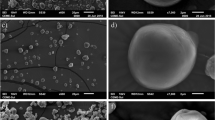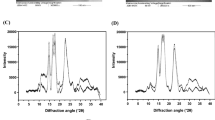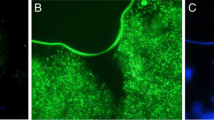Abstract
Alternative vectors to deliver viable cells of probiotics, to those conferring limited resistance to gastrointestinal conditions, still need to be sought. Therefore the main goal of the study was to develop tablets able to protect entrapped probiotic bacteria from gastric acidity, thus providing an easily manufacturing scale-up dosage form to deliver probiotics to the vicinity of the human colon. Whey protein concentrate microparticles with Lactobacillus paracasei L26 were produced by spray-drying and incorporated in tablets with cellulose acetate phthalate and sodium croscarmellose. The viability of L. paracasei L.26 throughout tableting as well as its gastric resistance and release from the tablets were evaluated. Storage stability of L. paracasei L26 tablets was also performed by evaluation of viable cells throughout 60 days at 23°C and 33% relative humidity. A decrease of approximately one logarithmic cycle was observed after the acid stage and the release of L. paracasei L26 from the tablets occurred only after 4 h in the conditions tested. Microencapsulated L. paracasei L26 in tablets revealed some susceptibility to the storage conditions tested since the number of viable cells decreased 2 log cycles after 60 days of storage. However, the viability of L. paracasei L26 after 45 days of storage did not reveal significant susceptibility upon exposure to simulated gastrointestinal conditions. The developed probiotic tablets revealed to be potential vectors for delivering viable cells of L. paracasei L26 and probably other probiotics to persons/patients who might benefit from probiotic therapy.



Similar content being viewed by others
REFERENCES
FAO/WHO. Evaluation of Health and Nutritional Properties of Probiotics in Food Including Powder Milk with Live Lactic Acid Bacteria Report of a Joint Expert Consultation. Córdoba-Argentina2001 1–4 October 2001.
Lourens-Hattingh A, Viljoen BC. Yogurt as probiotic carrier food. Int Dairy J. 2001;11(1–2):1–17.
Holzapfel WH, Haberer P, Geisen R, Bjorkroth J, Schillinger U. Taxonomy and important features of probiotic microorganisms in food and nutrition. Am J Clin Nutr. 2001;73(2 Suppl):365S–73S.
Cukrowska B, Motyl I, Kozakova H, Schwarzer M, Gorecki RK, Klewicka E, et al. Probiotic Lactobacillus strains: in vitro and in vivo studies. Folia Microbiol (Praha). 2009;54(6):533–7.
Pagnini C, Saeed R, Bamias G, Arseneau KO, Pizarro TT, Cominelli F. Probiotics promote gut health through stimulation of epithelial innate immunity. Proc Natl Acad Sci USA. 2010;107(1):454–9.
Kirjavainen PV, ElNezami HS, Salminen SJ, Ahokas JT, Wright PF. Effects of orally administered viable Lactobacillus rhamnosus GG and Propionibacterium freudenreichii subsp. shermanii JS on mouse lymphocyte proliferation. Clin Diagn Lab Immunol. 1999;6(6):799–802.
Lin PW, Nasr TR, Berardinelli AJ, Kumar A, Neish AS. The probiotic Lactobacillus GG may augment intestinal host defense by regulating apoptosis and promoting cytoprotective responses in the developing murine gut. Pediatr Res. 2008;64(5):511–6.
Naruszewicz M, Johansson ML, Zapolska-Downar D, Bukowska H. Effect of Lactobacillus plantarum 299v on cardiovascular disease risk factors in smokers. Am J Clin Nutr. 2002;76(6):1249–55.
Cremonini F, Di Caro S, Nista EC, Bartolozzi F, Capelli G, Gasbarrini G, et al. Meta-analysis: the effect of probiotic administration on antibiotic-associated diarrhoea. Aliment Pharmacol Ther. 2002;16(8):1461–7.
Ohashi Y, Nakai S, Tsukamoto T, Masumori N, Akaza H, Miyanaga N, et al. Habitual intake of lactic acid bacteria and risk reduction of bladder cancer. Urol Int. 2002;68(4):273–80.
Tok E, Aslim B. Cholesterol removal by some lactic acid bacteria that can be used as probiotic. Microbiol Immunol. 2010;54(5):257–64.
Goldin BR, Gorbach SL. Clinical indications for probiotics: an overview. Clin Infect Dis. 2008;46 Suppl 2:S96–S100. discussion S44-51.
Hilton E, Kolakowski P, Singer C, Smith M. Efficacy of Lactobacillus GG as a diarrheal preventive in travelers. J Travel Med. 1997;4(1):41–3.
Stadler M, Viernstein H. Optimization of a formulation containing viable lactic acid bacteria. Int J Pharm. 2003;256(1–2):117–22.
Del Piano M, Morelli L, Strozzi GP, Allesina S, Barba M, Deidda F, et al. Probiotics: from research to consumer. Dig Liver Dis. 2006;38(Supplement 2):S248–55.
Klayraung S, Viernstein H, Okonogi S. Development of tablets containing probiotics: effects of formulation and processing parameters on bacterial viability. Int J Pharm. 2009;370(1–2):54–60.
Albertini B, Vitali B, Passerini N, Cruciani F, Di Sabatino M, Rodriguez L, et al. Development of microparticulate systems for intestinal delivery of Lactobacillus acidophilus and Bifidobacterium lactis. Eur J Pharm Sci. 2010;40(4):359–66.
Chan ES, Zhang Z. Encapsulation of probiotic bacteria Lactobacillus acidophilus by direct compression. Food Bioprod Process. 2002;80(2):78–82.
Poulin JF, Caillard R, Subirade M. Beta-Lactoglobulin tablets as a suitable vehicle for protection and intestinal delivery of probiotic bacteria. Int J Pharm. 2011;405(1–2):47–54.
Calinescu C, Mulhbacher J, Nadeau T, Fairbrother JM, Mateescu MA. Carboxymethyl high amylose starch (CM-HAS) as excipient for Escherichia coli oral formulations. Eur J Pharm Biopharm. 2005;60(1):53–60.
Vidhyalakshm R, Bhakyaraj R, Subhasree R. Encapsulation the future of probiotics—a review. Adv Biol Res. 2009;3:96–103.
Kailasapathy K. Microencapsulation of probiotic bacteria: technology and potential applications. Curr Issues Intest Microbiol. 2002;3(2):39–48.
Burgain J, Gaiani C, Linder M, Scher J. Encapsulation of probiotic living cells: from laboratory scale to industrial applications. J Food Eng. 2011;104(4):467–83.
Gardiner GE, O’Sullivan E, Kelly J, Auty MAE, Fitzgerald GF, Collins JK, et al. Comparative survival rates of human-derived probiotic Lactobacillus paracasei and L. salivarius strains during heat treatment and spray drying. Appl Environ Microbiol. 2000;66(June):2605–12.
Rodrigues D, Sousa S, Rocha-Santos T, Silva JP, Lobo JMS, Costa P, et al. Influence of l-cysteine, oxygen and relative humidity upon survival throughout storage of probiotic bacteria in whey protein-based microcapsules. Int Dairy J. 2011;21(11):869–76.
Miles AA, Misra SS, Irwin JO. The estimation of the bactericidal power of the blood. J Hyg (Lond). 1938;38(6):732–49.
Madureira AR, Amorim M, Pintado ME, Gomes AMP, Malcata FX. Protective effect of whey cheese upon probiotic strains exposed to simulated gastrointestinal conditions. Food Res Int. 2011;4(1):465–70.
Rowe RC, Sheskey PJ, Weller PJ, editors. Handbook of pharmaceutical excipients. 4th ed. London, Chicago: Pharmaceutical Press American Pharmaceutical Association; 2003.
US FDA. Inactive Ingredient Search for Approved Drug Products. http://www.accessdata.fda.gov/scripts/cder/iig/index.cfm. Accessed 15 Mar 2012.
US FDA. CFR—Code of Federal Regulations Title 21. http://www.accessdata.fda.gov/scripts/cdrh/cfdocs/cfCFR/CFRSearch.cfm?fr=184.1979c. Accessed 15 Mar 2012.
Brachkova MI, Duarte A, Pinto JF. Evaluation of the viability of Lactobacillus spp. After the production of different solid dosage forms. J Pharm Sci-Us. 2009;98(9):3329–39.
ACKNOWLEDGMENTS
The authors gratefully acknowledge Formulab and DSM for providing the whey protein concentrate and probiotic strain, respectively. This work was funded by FEDER under the Operational Program for Competitiveness Factors—COMPETE and by National funds via FCT—Fundação para a Ciência e a Tecnologia within the framework of project PROBIOCAPS—references PTDC/AGR-ALI/71051/2006 and FCOMP-01-0124-FEDER-008792, and through individual research grants (SFRH/BPD/73781/2010, SFRH/BD/77647/2011 and SFRH/BPD/65410/2009) by FCT under QREN–POPH funds, co-financed by the European Social Fund and Portuguese National Funds from MCTES.
Author information
Authors and Affiliations
Corresponding author
Rights and permissions
About this article
Cite this article
e Silva, J.P.S., Sousa, S.C., Costa, P. et al. Development of Probiotic Tablets Using Microparticles: Viability Studies and Stability Studies. AAPS PharmSciTech 14, 121–127 (2013). https://doi.org/10.1208/s12249-012-9898-9
Received:
Accepted:
Published:
Issue Date:
DOI: https://doi.org/10.1208/s12249-012-9898-9




